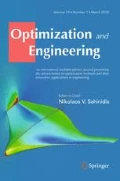Abstract
The goals of this paper are: (1) to bring attention to the existence and utility of multiple optimal rankings for the linear ordering problem, (2) to make the case for finding some or all of these multiple optimal rankings, (3) to provide an efficient algorithm that determines the existence of multiple optimal rankings, (4) to provide algorithms that find a sample of all optimal rankings, and (5) to connect multiple optimal rankings to fairness in ranking. We create algorithms to find the two nearest optimal rankings, the two farthest optimal rankings, and a so-called centroid ranking nearest to the centroid, which summarizes the information in all optimal rankings.












Similar content being viewed by others
Notes
The features of interest for the student dominance matrix and the parent dominance matrix were selected by our colleague Amanda Miller, College Planner, The Davidson Center.
Because in nearly all cases the optimal ranking produced by Model (4) is indeed the optimal ranking closest to the true centroid, for ease in subsequent descriptions we use the term centroid, acknowledging that there are some cases for which approximate centroid is the more accurate phrase.
An alternative model for finding a nearest pair across two datasets appears in Kondo (2014).
References
Achterberg, T.: Scip: solving constraint integer programs. Math Program Comput 1(1), 1–41 (2009)
Ali, I., Cook, W.D., Kress, M.: On the minimum violations ranking of a tournament. Manag Sci 32(6), 660–672 (1986)
Anderson, P., Chartier, T., Langville, A.: The rankability of data. SIAM J Math Data Sci (1), 121–143 (2019)
Anderson P, Chartier T, Langville A, Pedings-Behling K (2021) The rankability of weighted data from pairwise comparisons. Found Data Sci (2639–8001–2019–0–29):1–26
Biega AJ, Gummadi KP, Weikum G (2018) Equity of attention: Amortizing individual fairness in rankings. In: The 41st international acm sigir conference on research & development in information retrieval. pp 405–414
Biega AJ, Saha Roy R, Weikum G (2017) Privacy through solidarity: A user-utility-preserving framework to counter profiling. In: Proceedings of the 40th international ACM SIGIR conference on research and development in information retrieval. pp 675–684
Cassady, C.R., Maillart, L.M., Salman, S. (2005) Ranking sports teams: a customizable quadratic assignment approach. Interfaces 35(6), 497–510
Coleman, B.J.: Minimizing game score violations in college football rankings. Interfaces 35(6), 483–496 (2005)
Fukuda, K., Prodon, A.: Double description method revisited, pp 91–111. Springer, Berlin (1996)
Garey MR, Johnson DS (1979) Computers and Intractability: a Guide to the Theory of NP-Completeness. Freeman, New York
Grotschel, M., Junger, M., Reinelt, G.: A cutting plane algorithm for the linear ordering problem. Oper Res 32(6), 1195–1220 (1984)
Hardt M, Price E, Srebro N (2016) Equality of opportunity in supervised learning. arXiv:1610.02413
Kamishima T, Akaho S, Asoh H, Sakuma J (2012) Fairness-aware classifier with prejudice remover regularizer. In: Joint European conference on machine learning and knowledge discovery in databases. Springer, pp 35–50
Kearns M, Roth A, Wu ZS (2017) Meritocratic fairness for cross-population selection. In: International conference on machine learning. PMLR, pp 1828–1836
Kondo, Y.: Triangulation of Input-Output Tables Based on Mixed Integer Programs for Inter-temporal and Inter-regional Comparison of Production Structures. J Econ Struct 3(1), 1–19 (2014)
Leontief, W.: Input-Output Economics. Oxford University Press, New York (1986)
Leontief WW (1986) Input-Output Economics, 2nd edn. Oxford University Press, Oxford
Martí R (2009) Linear Ordering Problem Instances. http://grafo.etsii.urjc.es/optsicom/lolib/. [Online; accessed 10-June-2021]
Marti R, Laguna M, Duarte A (2017) Lop instances and best known solutions. http://heur.uv.es/optisom/LOLIB
Marti, R., Reinelt, G.: The Linear Ordering Problem: exact and heuristic methods in combinatorial optimization. AMS, Providence (2011)
Mehrotra S, Ye Y.: Finding an interior point in the optimal face of linear programs. Math Prog 62, 497–515 (1993)
Park J.: On minimum violations ranking in paired comparisons (2005). arXiv:physics/0510242
Pedings KE (2011) Minimum violations ranking using evolutionary optimization and binary integer linear program approaches. Master’s thesis, College of Charleston
Pedings KE, Langville AN, Yamamoto Y.: A minimum violations ranking method. Optim Eng 13(2), 349–370 (2012)
Reinelt, G.: The Linear Ordering Problem: Algorithms and Applications. Heldermann Verlag, Berlin (1985)
Reinelt G, Grötschel M, Jünger M (1983) Optimal triangulation of large real world input-output matrices. Stat Pap 25(1), 261–295
Sakuraba CS, Ronconi D, Birgin E, Yagiura M.: Metaheuristics for large-scale instances of the linear ordering problem. Expert Sys Appl. 42(9), 4432–4442 (2015)
Schiavinotto, T., Stützle, T.: The linear ordering problem: Instances, search space analysis and algorithms. J Math Modell Algorithms 3(4), 367–402 (2005)
Acknowledgements
We thank Linda LeFauve, Associate Vice President for Planning and Institutional Research, Davidson College, for sharing the US News and World Report college data and Amanda Miller, College Planner, The Davidson Center, for providing advice on a subset of colleges and features to analyze.
Author information
Authors and Affiliations
Corresponding author
Additional information
Publisher's Note
Springer Nature remains neutral with regard to jurisdictional claims in published maps and institutional affiliations.
Rights and permissions
About this article
Cite this article
Anderson, P.E., Chartier, T.P., Langville, A.N. et al. Fairness and the set of optimal rankings for the linear ordering problem. Optim Eng 23, 1289–1317 (2022). https://doi.org/10.1007/s11081-021-09650-y
Received:
Revised:
Accepted:
Published:
Issue Date:
DOI: https://doi.org/10.1007/s11081-021-09650-y




